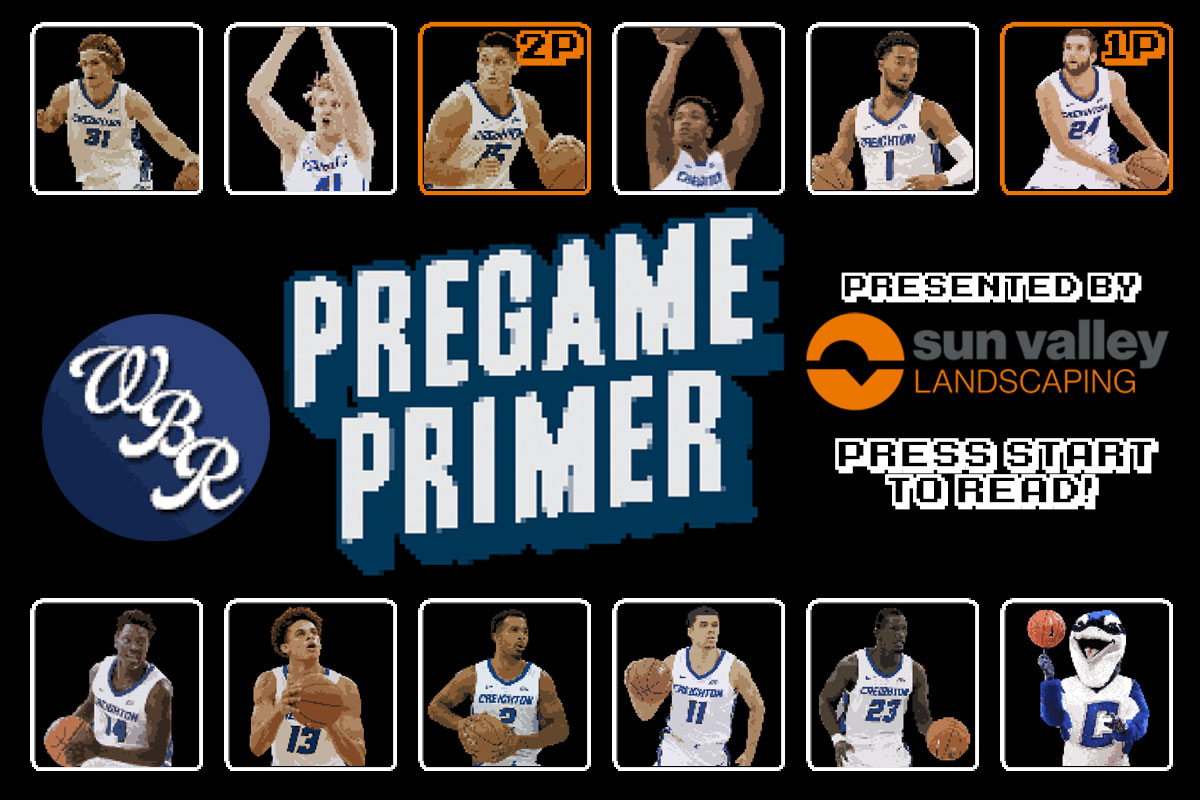[dropcap]Creighton[/dropcap] hasn’t started 2-0 in league play — MVC or Big East — with both wins coming on the road since 1941-42. They’ll get a chance to do just that on Saturday when they take on a reeling Butler Bulldogs team at Hinkle Fieldhouse. The Bulldogs were pummeled at Florida last Saturday, falling behind 21-0, eventually trailing by as many as 37 points, and losing 77-43 in Gainesville for their most lopsided defeat in 25 years. Then they fell behind at home by as many as 16 points to Georgetown, used a 10-0 run to pull within five with 1:22 to play, then surrendered a 10-0 run to end the game and drop their Big East opener 84-76.
The back-to-back losses have sent Bulldogs fans into panic mode; a look at their message board or a search on Twitter turns up a litany of posts from an angry, frustrated fanbase questioning the direction of the program, the ability of the coaching staff, and the short-and-long-term outlook for the team. Is it a vocal minority, or an accurate pulse of the fanbase at-large? That’s hard to say, but the team itself is certainly feeling the pressure. David Woods wrote as much in the Indianapolis Star after the Georgetown loss, saying:
“There is no metric for anxiety in college basketball. Yet based on the way they defended, the way they lost and the way they spoke, the Butler Bulldogs are feeling it.
After a second successive knockout, the Bulldogs’ opponent might be looking back at them in the mirror.”
They were picked by the media to finish fifth in the league and contend for a fifth-straight NCAA Tournament berth, so a 9-5 start — with some concerning losses — is a bit surprising. But in retrospect, this is a team with glaring weaknesses that perhaps weren’t as obvious back in October. After all, Kelan Martin (21.2 points, 6.3 rebounds, 2.0 assists per game) and Tyler Wideman (9.3 points, 5.1 rebounds) are gone, taking with them two of their top four scorers, and their two best rebounders. And the veterans expected to step right in and keep the ship sailing smoothly have not done that.
Kamar Baldwin is the top scoring option now, and while his averages are certainly impressive (15.7 points, 5.4 rebounds, 1.5 steals per game), he’s still plagued by the same problem he had a year ago — inconsistency. Last season he scored 34 total points over the final four regular season games, then hung 32 in one game against Seton Hall in the Big East Tourney. Similarly, in early February, he had 25 against #1 Villanova, then scored 31 total points the next three games.
This year, Baldwin has continued that trend, except now instead of being the second fiddle to an All-Big East caliber talent — meaning they could weather a cold shooting night much easier — he’s the top option. So games like the blowout loss at Florida, where he scores nine points on 3-of-12 shooting with only three rebounds, are lethal instead of merely concerning. Even his higher scoring games over the last six weeks have been less than efficient; he needed 19 shots to score 17 points against Georgetown (7-of-15 on two-pointers, 1-of-4 on threes), and 19 shots to score 16 points against Indiana (6-of-16 on twos, 1-of-3 on threes).
Baldwin is primarily an inside-the-arc presence despite his 6’1″ frame; just 30% of his shots are three-pointers, and he makes around 28% of the ones he takes. Luckily for Butler they have a pair of sharpshooting specialists to surround him with in Paul Jorgensen and Sean McDermott. Jorgensen (13.9 points per game) and McDermott (10.8 points per game) have combined to make 75 threes so far this year, and both shoot north of 40% from behind the arc. Those three players have combined to take 60% of Butler’s shots, and scored 55% of their points.
Jorgensen’s season got off to a great start, as he scored in double figures in each of the team’s first six games, and eight of their first nine (and he had nine points in the only game he failed to crack double digits). Since then, he’s only been in double figures once — not coincidentally, the only game of those five where he shot the ball well from three-point range. He was 2-of-10 (and 1-of-6 on threes) for five points against Indiana, 1-of-5 for four points against Presbyterian, 2-of-6 (and 1-of-4 on threes) against Florida, and 2-of-7 (and 1-of-4 on threes) against Georgetown. He snapped out of the slump momentarily against UC Irvine on December 21, making 5-of-7 from long range on the way to 19 points — but even then, he was 1-of-7 on two-pointers.
Over half of his shots are threes, and over 80% of his shots are jumpers, which is why he doesn’t get to the line very often. He’s a streaky shooter, and right now he’s on the down side of the streak. Let’s hope he stays there for at least one more game, because he was a one-man wrecking crew against Creighton last year. He had 17 points, five rebounds and three assists in Indianapolis, making 7-of-11 shots (and 3-of-4 from behind the arc). And he scored 18 in Omaha on 8-of-17 shooting.
McDermott has also been mired in a shooting slump the last two-plus weeks, but unlike Jorgensen, hasn’t taken a ton of shots trying to get out of it — he’s just mostly been invisible. He took four shots and scored five points in 28 minutes against Presbyterian. He was 1-of-6 for five points against UC Irvine. He was 1-of-5 for three points against Florida. And he was 3-of-7 for nine points against Georgetown. Like Jorgensen, the vast majority of his shots are jumpers, but unlike Jorgensen, he doesn’t have much of a midrange game or even the ability to put the ball on the floor to turn a decent look into a better look. 82% of his shots — 92 of the 112 attempts he’s had this season — have been three pointers. 94.9% of those have been assisted by a teammate.
He didn’t do much against CU a year ago, scoring 12 total points in two games. While he’s not a player who’s going to create shots for himself, he’s dangerous if you have a brain cramp defensively and give him space on the perimeter.
Rounding out the starting five are Aaron Thompson, a 6’2″ sophomore averaging 6.4 points and 1.9 rebounds, and Nate Fowler, a 6’10” senior averaging 4.9 points and 4.1 rebounds. They’ve used the same five players in the starting lineup all 14 games, which is significant because those five play the majority of the minutes — among players who’s been on the on the floor every game, just three other players average double-figures in minutes played.
Not among them? Sophomore Jordan Tucker, who was the #40 recruit in the Class of 2017 and began his career at Duke. He transferred to Butler midseason a year ago, and became eligible when the fall semester ended on December 15. The 6’7″, 210 pound Tucker has played in all five games since becoming eligible, getting more and more effective the more comfortable he gets on the floor. He’s averaging 8.2 points and 4.2 rebounds a game, shoots 45% from three (10-of-22) and is a bit of an ace in the hole for the Bulldogs — if he becomes anything close to the player he was expected to be coming out of high school over the next six weeks, Butler becomes a much more dangerous team.
Incidentally, fun fact about Tucker: he’s the nephew of Dwight Myers, better known as “Heavy D” of Heavy D And The Boyz fame.
The current roster is comprised of players from recruiting classes ranked 9th, 9th, 7th, and 9th in the Big East the last four seasons (according to 247’s composite rankings). Players improve, certainly, and you can overcome recruiting rankings somewhat through superior coaching, transfers, and by getting under-the-radar players that fit your culture and style of play perfectly. But it also can’t totally be dismissed. At this moment, Butler is a team that will go only as far as Baldwin, Jorgensen and McDermott can take them — and with a streaky #1 scoring option, and their two primary three-point weapons in a slump at the same time, they’re going to struggle against good teams.
With that said, Baldwin is capable of going off for 30+ and of creating shots for others. Jorgensen is capable of hitting six or seven 3-pointers in a game to light up a defense and open driving lanes for Baldwin. McDermott is a terrific catch-and-shoot guy when he’s feeling it. Butler’s going to win games because their slow pace of play will bother opponents, their defense — while not as good as years past — is still solid, and their offensive weapons won’t continue to slump concurrently. For Creighton, the hope is they can rebound well enough to run in transition at least somewhat, utilize that transition game to create open shots before Butler’s defense can get set, and play good enough defense to keep Butler’s shooters in a slump.
Do that, and Creighton stands a pretty good chance of returning home 2-0 in the league.

- Tip: 11:00am
- Venue: Hinkle Fieldhouse, Indianapolis, IN
- TV: FS1
- Announcers: Justin Kutcher and Nick Bahe
- In Omaha: Cox channel 78 (SD), 1078 (HD); CenturyLink Prism channel 620 (SD), 1620 (HD)
- Outside Omaha: FS1 Channel Finder
- Satellite: DirecTV channel 219, Dish Network channel 150
- Streaming on FoxSportsGO
- Radio: 1620AM
- Announcers: John Bishop and Tyler Clement
- Streaming on 1620TheZone.com and the 1620 The Zone mobile app
- For Cord Cutters:

- 6’11”, 230-pound sophomore Joey Brunk’s .712 (42-59) field goal percentage leads the team (though he does not have enough attempts to qualify currently for the Big East and NCAA leaderboards). Six of Brunk’s seven career double-digit scoring performances have come this season, including 11 points on 5-of-8 shooting against Georgetown earlier this week.
- Only four of Butler’s 14 opponents this season have scored more than 70 points (Florida on the road, Ole Miss, Indiana, and Georgetown). The Bulldogs’ defense is allowing only 65.9 points per game on average, which is the stingiest mark in the Big East and Top 50 nationally. That’s partially because of good defense — they’ve held opponents to a 51.2% effective field goal percentage, 35% three-point shooting percentage, and 49% two-point shooting percentage, all ranking among the top one-third of D1 teams. They’ve also forced a turnover on 21% of opponent’s possessions, ranking 81st in D1. But it’s also because of pace — Butler is one of the slowest teams in America. Their adjusted tempo is 66.7, ranking 306th out of 351 teams, and their average possession length is 18.5 seconds, ranking 301st. They’ve had just two games all season with more than 70 possessions.
- Butler is averaging only 10.9 turnovers per game, which leads the Big East and is top 15 nationally. Butler is also second in the Big East in assist/turnover ratio (1.3).

- With a win, Creighton will start 2-0 in Big East play for the second time ever, joining the 2013-14 club that would finish 14-4 and in second place at year’s end. It would also improve Greg McDermott to 198-98 at Creighton, moving him 100 games over the .500 mark for the first time.
- Each of Creighton’s first five Big East games are against a team picked to finish in the upper division of the league, while the sixth is a road contest against a vastly improved Georgetown team that is currently 10-3. Creighton is the only school to start league play with five straight games against teams picked in the top five of the preseason poll, and the only team in the Big East that has consecutive road games to start league play this season. That’s happened just twice in the last 36 years — 1994-95 and 2014-15 are the only other times they’ve begun league play with two road games.
- Creighton has made 10 or more three-pointers in 10 of its last 11 games, shooting 140-for-314 (.446) from deep in that time. In this run, CU has shot better than 38.5 percent from deep in all but one of those games, and shot 43.8 percent from distance or better nine times. Creighton has averaged 88.5 points per game in the span.

Creighton holds a 10-7 lead in the series, and is 3-5 in games played in Indianapolis. They’re 2-3 at Hinkle Fieldhouse since joining the Big East — a 76-67 win in 2017 for their first big win post-Mo Watson injury, and a 68-63 win in 2014 where Doug McDermott hit the eventual game-winner in the final minute.
The last time they met, Butler blew out the Jays 93-70 in Indianapolis. The less said about that game, the better.

Rob Anderson shared updates on a whole bunch of former Bluejays playing professionally — namely, the ones not in the NBA. Here they are:
#ProJays update:
Marcus Foster is averaging 25.9 points, 5.6 rebounds and 4.0 assists per game for DB Promy (South Korea) this season. #Creighton pic.twitter.com/2ujzPBzFYB
— Rob Anderson (@_robanderson) January 3, 2019
#ProJays update:
Geoffrey Groselle is averaging 14.2 oints, 6.4 rebounds and 1.2 blocks per game for BK Astana (Kazakhstan) this season. #Creighton pic.twitter.com/PtH8fluulL
— Rob Anderson (@_robanderson) January 3, 2019
#ProJays update:
Isaiah Zierden is averaging 6.9 points and 2.7 rebounds per game for Terceira Basket Susiarte (Portugal) this season. #Creighton pic.twitter.com/FzDyqFb3i6
— Rob Anderson (@_robanderson) January 3, 2019
#ProJays update:
Manny Suarez is averaging 13.9 points and 8.9 rebounds per game for Club Desportes Castro (Chile) this season. #Creighton pic.twitter.com/DbCE3vvTtQ
— Rob Anderson (@_robanderson) January 3, 2019
#ProJays update:
Will Artino is averaging 18.4 points, 10.9 rebounds and 1.8 steals per game for the Formosa Dreamers (Taiwan) this season. #Creighton pic.twitter.com/oPCDS4Dh44
— Rob Anderson (@_robanderson) January 3, 2019
#ProJays update:
Austin Chatman owns 27 points, 20 assists and 12 rebounds in 14 games this season for the Sioux Falls (South Dakota) Skyforce in the G-League. #Creighton pic.twitter.com/ajeJlGeXxP
— Rob Anderson (@_robanderson) January 3, 2019
#ProJays update:
Jahenns Manigat is averaging 11.9 points, 3.7 rebounds, 3.2 assists and 1.6 steals per game for DEAC (Hungary) this season. #Creighton pic.twitter.com/TaDfTVIjzB
— Rob Anderson (@_robanderson) January 3, 2019
#ProJays update:
James Milliken is averaging 16.1 points and 4.6 assists per game for TSU-Hyundai (Georgia) this season. #Creighton pic.twitter.com/JN4YpRGLYN
— Rob Anderson (@_robanderson) January 3, 2019
#ProJays update:
Kenny Lawson Jr. is averaging 16.2 points and 7.1 rebounds per game for Unieuro Forli (Italy) this season. #Creighton pic.twitter.com/TdOibxMeXQ
— Rob Anderson (@_robanderson) January 3, 2019
#ProJays update:
Gregory Echenique is averaging 19.6 points and 14.6 rebounds per game for Shimane Susanoo Magic (Japan) this season. #Creighton pic.twitter.com/t49zFjrFzm
— Rob Anderson (@_robanderson) January 3, 2019

Creighton has won 7 straight (and 12 of its last 13) games played on January 5th, including a 1974 win at Butler. The only coach to beat CU on January 5th in that time? Ex-Northern Iowa coach Greg McDermott in 2002.
On January 5, 2013, Creighton defeated Indiana State 79-66 to move to 3-0 in the league in their final run through the Missouri Valley.
The Trees led 27-21 with under three minutes to play in the first half, and then Gregory Echenique blocked not one, not two, but THREE STRAIGHT Indiana State shot attempts — sending the first one four rows deep into the stands. It gave a huge crowd waiting for a reason to explode the chance to yell, and gave the players the energy they needed to make a 6-0 run that tied the game at the break. Echenique’s Block Party starts around the 1:45 mark of the Highlight Reel:
They carried that momentum into the second half, scoring 52 points after the break and making 8-of-13 three pointers. But with both Doug McDermott and Ethan Wragge in foul trouble, they never really created separation until late in the game. From the Morning After:
“Gregory Echenique scored a layup on the other end to make it 44-43, then converted a three-point play on the next possession to tie the game at 46. Manny Arop nailed a three for ISU on their next possession, and it was immediately answered by a three from Ethan Wragge. Jake Odum then scored a bucket on ISU’s next trip down the floor to make it 51-49. It would be the Trees’ last lead of the afternoon, and the last field goal they would make for nearly six minutes.
Echenique tied it 18 seconds later on another bucket, then threw down a rim-shattering dunk on the next possession that had seemingly half the crowd mimicking Jahenns Manigat’s “muscle flex” gesture. Another three from Wragge followed, and as McDermott checked back in it was 56-52 Creighton. The 7-1 run his teammates had gone on without him turned into a 16-2 run following his return, with McDermott scoring six of Jays’ next nine points. When all was said and done, it was 65-53 Jays with just over five minutes to go, and the game was for all intents and purposes over.”

C’mon now. You don’t really think I could mention Heavy D & The Boyz up above and *not* use their biggest hit here, did you?
The Bottom Line:
There’s two schools of thought here. The first is that Creighton is catching Butler at a terrible time — they’ve played poorly two straight games, there’s a little bit of us-against-the-world mentality happening, and their backs are against the wall because starting 0-2 in the league by losing twice at home could send their season spiraling out of control. If you buy that line of thinking, Butler is likely to come out with a little extra spark, and Creighton will be required to match that intensity in order to hang around in this one.
The second? That Creighton is catching Butler at a great time, when they’re questioning themselves and struggling to find answers.
I think the first is more likely than the second, but I like Creighton’s chances of winning a heckuva lot more than I did a week ago. So much so that I’ll predict a four-point Jays win.
Creighton 77, Butler 73


